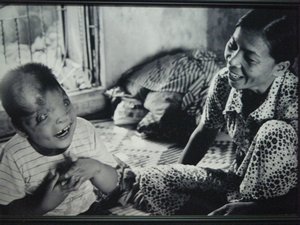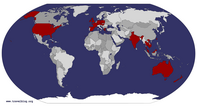Advertisement
Published: March 11th 2010

 Agent orange
Agent orange
A photo at the War Remnants Museum of a child affected by agent orange.We hold these truths to be self-evident that all men are created equal, that they are endowed by their Creator with certain unalienable Rights, that among these are Life, Liberty and the pursuit of Happiness
- the unanimous Declaration of the thirteen united States of America
Harrowed, overwhelmed, embarrassed, enlightened, frightened, saddened, outraged, appalled, incredulous… Just a few minutes inside the
War Remnants Museum in Saigon elicited these strong emotions.
The War Remnants Museum, which opened in September 1975, just after the fall of Saigon, denotes its role as “the unique museum in Vietnam to systematically study, collect, preserve and display exhibits on war crimes and aftermaths foreign aggressive forces caused for Vietnamese people.” Specifically, it covers the Vietnam War, known here as the American War. The museum acknowledges its role quite explicitly, with the United States as a perpetrator of “war crimes” and “genocide” and the Vietnamese opposition as “patriots”.
Inside the museum, I made my way past several pictures, allegedly taken during the war, that showed some of the war crimes to which the brochure’s message alluded. A soldier posing in front of a VC skull mounted on his tent. Dead and lifeless bodies of VC being drug behind an armored vehicle. Soldiers posing in front of corpses with a message allegedly written by Army brass on becoming “a psycho killer like the Lifer (E-6) in the picture”. A soldier

 Atrocities
Atrocities
Damning evidence of some of the atrocities that US soldiers committed during the Vietnam war. Hopefully these are just a concentration of a few incidents and not pervasive.holding the remains of a VC for a photo. X-rays of Vietnamese people who allegedly had their knees busted under interrogation “for no reason”. The effects of chemical warfare on women and children civilians. Years later, the state of many people with severe physical defects they received as children during the war. A sign denoting three million Vietnamese killed - among them two million civilians - another two million injured and 300,000 missing. Plus three future generations worth of people that will suffer from the effects of agent orange. Bodies lying in heaps like those seen in the Nazi concentration camps of WWII.
Next to these pictures was a display of some of the text from our Declaration of Independence. Not just any text, but the element that defines our nation above all else - the reason we became a country in the first place, the basis for what we later expressed in the Constitution and Bill of Rights and the foundation on which our entire concept of life exists - that all human beings have the right to life, liberty and the pursuit of happiness. At our founding, a few patriots of our own believed that tyranny and

 Smile
Smile
Not the way you want to be portrayed for posterity.oppression existed at a level so extreme that they warranted a war and the loss of many lives to bring about a government where unalienable rights are endowed upon all men.
As this message rung so true in my head and I saw it displayed against us - with what appeared to be some validity - I got a bit choked up and had to squat down to compose myself.
This was the side we never see.
In the United States, our grade school and college history coursework tends to focus on evolution, Egypt, Greco-Roman times, a bit of the middle ages, the Renaissance and exploration and American-focused history - colonization, the Revolutionary War and War of 1812, the Civil War, the industrial revolution, Great Depression and, if we’re lucky, a quick look at WWII. Other than an occasional look at the civil rights movement - often done in other courses - no one makes it to the last 60 years, covering the spread of communism and its source, the Korean War, the Cold War, the fall of communism, wars in the Middle East and, most relevant to me at the moment, the Vietnam War.
Therefore, I

 Huey
Huey
A huey helicopter outside the War Remnants Museum.have only a cursory knowledge of the Vietnam War, with a perspective solely from our side, based on visits to museums, books, documentaries and some glorified war movies. In those, all that was ever really seen in opposition to the war were protests by hippies who were generally against all wars, not just this one.
What I thought I knew was a complete defiance to what was presented here today. I had to wonder how much here is true and what is propaganda. There was no mention of the atrocities of the Vietcong (VC), women and children with bombs strapped to them walking at soldiers, leaving them no alternative than to shoot, and the treatment of American POWs. The museum’s point of view is clearly one sided; perhaps much like our own, putting a spin to shirk any and all responsibility. As in many cases, the truth is likely somewhere in between.
In addition, I wondered how history will reflect our wars in Afghanistan and Iraq. Since there will likely be no clear cut victor with the complete decimation of the loser, the winner will not be given the opportunity to write history completely as it chooses. There

 Office
Office
The president's office - complete with red phone - in the Reunification Palace. will certainly be views from both sides. Someday, will we visit a museum in those places that speaks accurately or inaccurately of
war crimes and aftermaths foreign aggressive forces caused for the people of Afghanistan and Iraq? What will it show? Whose face, if anyone, will be portrayed above a message that says “An American soldier with the skull of an Al Qaeda patriot”? Hopefully no one’s, which is why we place so much faith in the officers in our military today to lead like the men of honor that we expect them to be.
Under the premise that the war was fought to quell the rise of communism in the United States, it also raises the philosophical debate on how far a country can go to protect its own interests and beliefs. Should it be allowed to preemptively strike in the event that if it doesn’t it faces a clear and present danger of being overtaken by force or by change? What channels must it take to resolve an issue by peace first. At what stage can it use force? And, in the case of the United States and other countries built on (and because of) the idea

 Chopper
Chopper
A replica of the huey chopper that was used to transport the South Vietnamese president to and from the palace.of freedom and equality, at what point does the protection of your own unalienable rights unduly breach the unalienable rights of another. The latter raises quite the conundrum for the United States.
No matter who was right or wrong and who did what to whom, this has certainly piqued my interest to get a much stronger grasp on the Vietnam War and the events leading up to it. Though I fear the real challenge will be finding worthwhile sources that seek to inform rather than support a cover up or crucifying agenda.
Outside the museum, which I actually explored first, were more of what I would have expected to see here. Huey and Chinook choppers. An A3 tank. Some fighter jets and bombs. Also outside was an replica of an imprisonment system section, complete with tiger cages (for keeping prisoners confined) and a guillotine. There were also many guns and unexploded bombs.
Much of the ordnance had been confiscated during the war by the VC guerillas. In guerilla warfare, one side uses its opponents strengths against it. In the war, this was the technology that the United States ended up providing to the VC that could be

 Basement bunker
Basement bunker
The palace's basement bunker with its archaic communications equipment.used against it. One of the most prolific was the use of unexploded bombs that were then used to create land mines. Today, in the propaganda war, a certain level of guerilla warfare remains by taking our country’s righteous views and using them against us.
Later in the day, some of the pictures were brought to life as we toured the Handicap Handicraft manufacturer. Formed after the fall of Saigon for those who suffered physical defects from the war, the Handicap Handicraft manufacturer is a place for people with disabilities to work. Inside, we were able to watch people work, many with very distinguishable deformities like missing limbs and deformed legs. The crafts they produced, mostly made of heavily lacquered wood, were extraordinarily beautiful.
The rest of the day paled in comparison to the museum and the handicraft manufacturer. We visited the Reunification Palace, which was formerly the residence of the head of the South Vietnamese government. Inside, we saw many of the 100 rooms, the most memorable including the map room, an office with the infamous red phone, the rooftop with a helicopter used for the president’s transportation and the basement bunker with all sorts of now

 Handicapped worker
Handicapped worker
A man with physical deformities works at the Handicapped Handicraft factory in Saigon.antiquated communications equipment.
Other stops included a tea house where they served hard boiled eggs pickled with tea, Thien Hau Temple, Binh Tay Market, a Vietnamese lunch, a Chinese Buddhist temple, a French Cathedral and the post office.
During the trip, I spoke with our tour guide, Du, about a few of the social policies here in Vietnam. There isn’t an income tax here but there also isn’t a well used public transportation system to relieve the traffic congestion or a public education system. Instead, both are left up to individuals to fend for themselves. Purchasing a motorbike can be as little as a few hundred dollars for a used Chinese made bike or several thousand dollars for a new Honda or Yamaha bike.
On the education side, most children do get some level of education, with about 90% in school at age 7 but only 50% at age 18. Though for many, the private cost is quite reasonable for the first several years, with an all-in $50-100 cost per child per year while rural residents make about $80 per month and urban residents make about $200 per month (in each case the cost is under 10%

 Crafts
Crafts
Some of the beautiful crafts made at the Handicapped Handicraft factory in Saigon.of annual income per child). Even so, those graduation rates are significantly lower than the western world.
I found it ironic that a system of government that is supposed to eliminate disparity between rich and poor actually encourages it, by widening the income potential gap. I was also surprised that the government isn’t involved in those areas, though it does affect people’s choices by imposing a two child limit.
Before having dinner at an Indian restaurant, I spent the rest of the day doing some trip planning and getting my hotel booked for Brian and Robin’s wedding in Puerto Rico next month. That will be the next trip.
Tomorrow I take a day trip to the Mekong Delta.
Advertisement
Tot: 0.071s; Tpl: 0.011s; cc: 6; qc: 24; dbt: 0.0384s; 1; m:domysql w:travelblog (10.17.0.13); sld: 1;
; mem: 1.1mb










